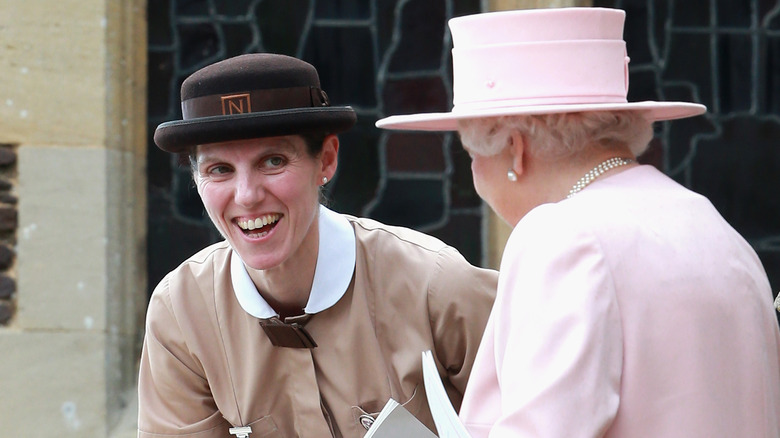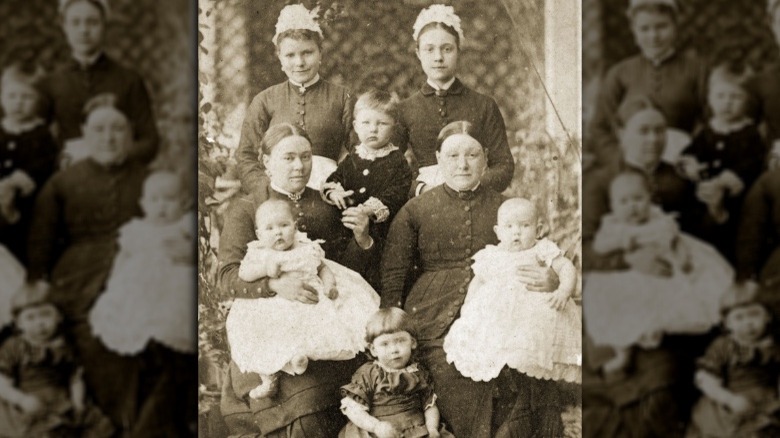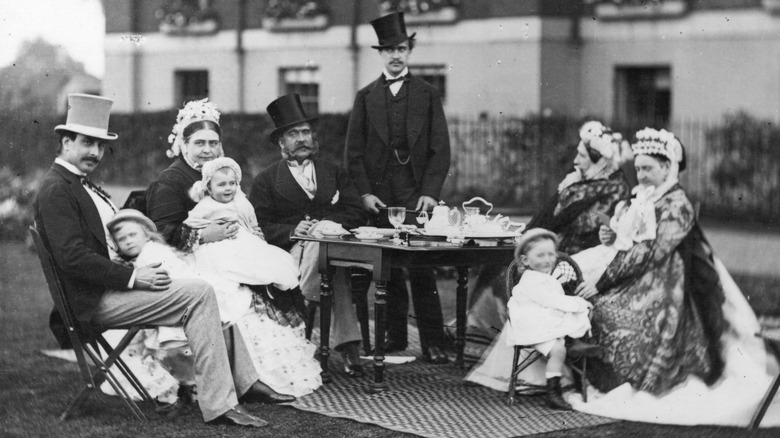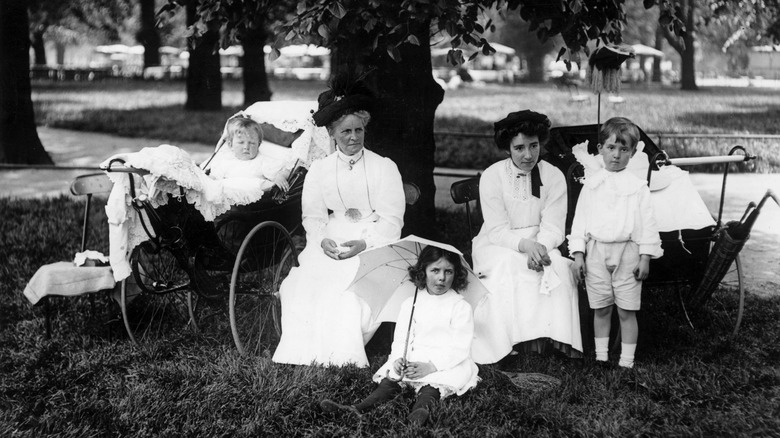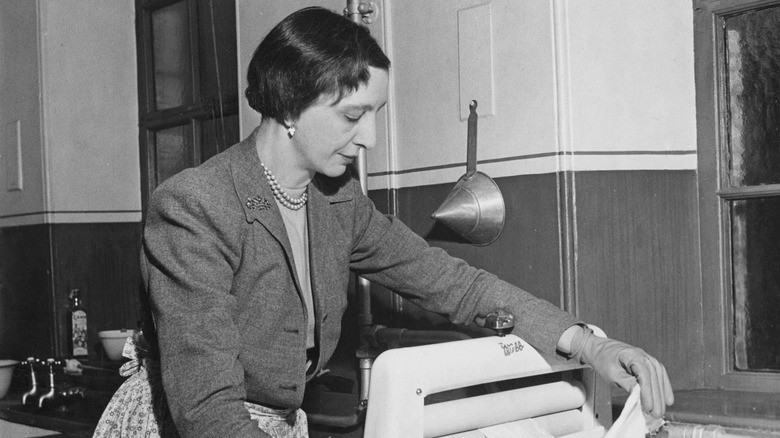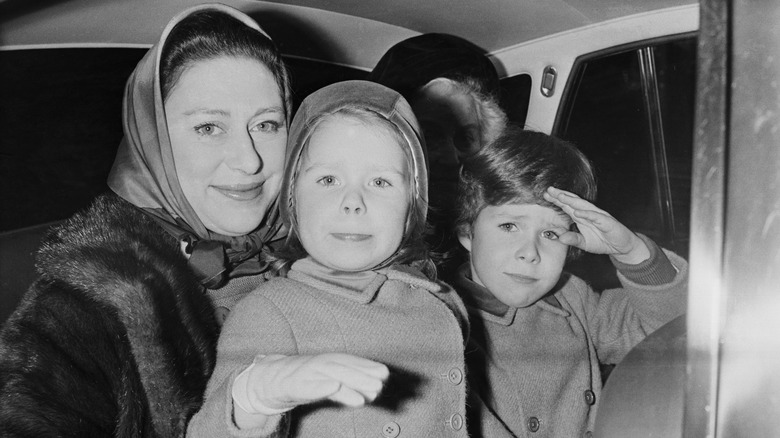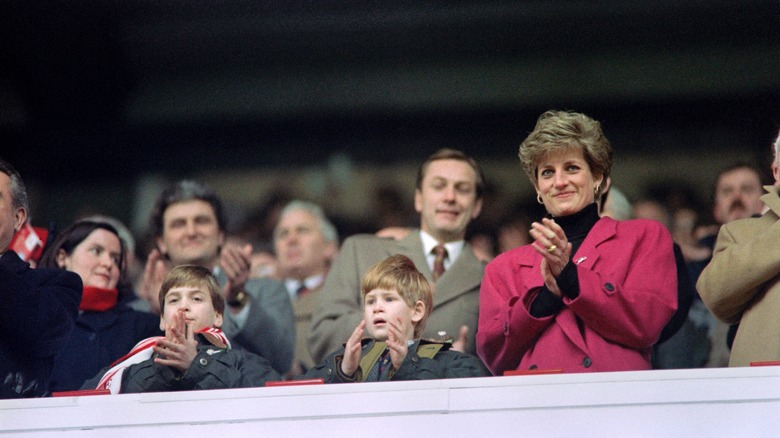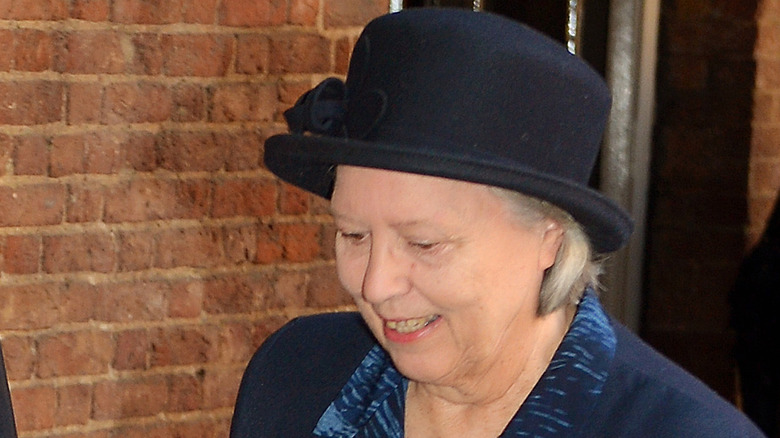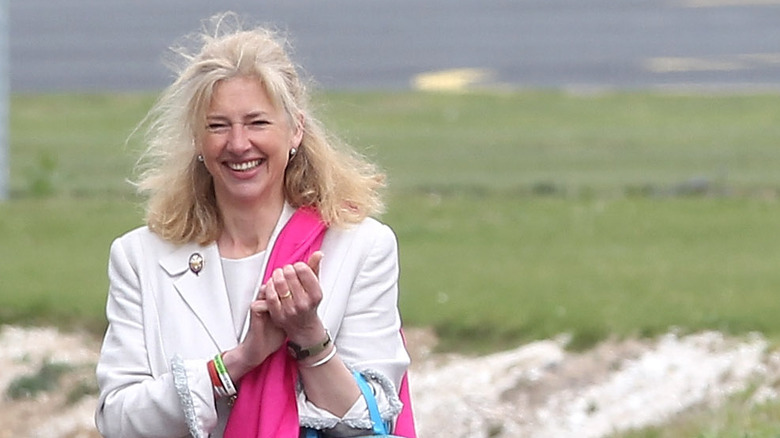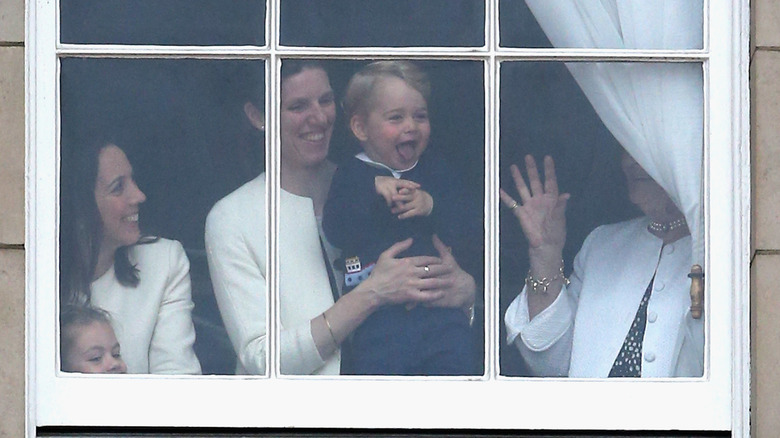The Untold Truth Of Royal Nannies
In October 2018, Kensington Palace confirmed much anticipated news. "Their Royal Highnesses The Duke and Duchess of Sussex are very pleased to announce that The Duchess of Sussex is expecting a baby in the Spring of 2019," the statement revealed. Prince Harry and Meghan Markle are officially going to be parents!
While many can't wait to get a glimpse at the little royal once he or she arrives, it will also be interesting to see how Harry and Meghan adapt to parenthood. Will they be hands-on like Prince William and Kate Middleton or more distant like Queen Elizabeth and Prince Philip?
You also have to wonder if the mom- and dad-to-be will end up choosing to hire a nanny. Carolyn Harris, author of Raising Royalty: 1,000 Years of Royal Parenting, told Town & Country that royals are encouraged to hire nannies due to having "extensive working responsibilities." However, they're not actually required to hire one. Want to know a few secrets about royal nannies from the past? Keep reading.
From governess to nanny
While nannies have been a part of the royal family for centuries, what is required of them — and what they are called — has changed over the years, BBC News reported. Royal childcare providers were once known as governesses, a word that was devised by royalty in 1483. Governesses were tasked with not only caring for the physical needs of a child or children, but also for educating them.
While royal nannies have a similar job description today, the term "governess" fell out of favor in the late 1800s. This was thanks to author Mary Hawker who unfairly characterized the women in Mademoiselle Ixe, writing that "good looks are rather out of place in a governess." Ouch. Although their name may have changed at the end of the 19th century, one thing would remain consistent into the 1900s: the royals allowed the hired help complete autonomy of the nurseries — and the children within them.
The tyrannical nanny
Uncle Ben may have said it best: "With great power comes great responsibility." Unfortunately, some nannies in the 19th and 20th centuries abused their power and became the stuff of nightmares.
If you watched The King's Speech, you'll recall the heartbreaking scene when King George VI, portrayed by Colin Firth, tells his speech therapist about his first nanny. A truly terrible person, she'd pinch him to get him to cry just before handing him off to his parents. This would prompt his parents to return the screaming child to the nanny, who would then torment the young prince — even refusing to feed him. "It took my parents three years to notice," King George revealed.
Although we wish this were just a Hollywood dramatization, King George did indeed suffer at the hands of his tyrannical nanny — Charles Carlton, Professor Emeritus of History at North Carolina State University and author of Charles I: the Personal Monarch, confirmed this in an article for History News Network.
Royal nannies weren't all bad
Although no nanny could undo the damage inflicted upon King George VI, his next nanny was as great as they come. Charlotte 'Lala' Bill was an under-nanny when she realized how the head nanny had been treating King George. After reporting the mistreatment to the young royal's parents, the head nanny was, naturally, fired. Thankfully, Bill then became the main nanny to King George and his brother Edward.
"Lala was a London woman to whom the children became attached," reads Inheritance: A Psychological History of the Royal Family by Dennis Friedman, a psychologist and royal commentator. "She was cheerful, kind and loving, as was their grandmother Queen Alexandra, and the two women did their best to provide the children with what they lacked in maternal love." Edward even developed a "faint Cockney accent" due to the time spent with the beloved nanny, which is perhaps the biggest indicator of just how involved she was in the children's upbringing.
Caregivers or secret-keepers?
When King George VI had children of his own, he entrusted a Scottish nanny, Marion "Crawfie" Crawford, to care for his daughters, Princess Margaret and Princess (now Queen) Elizabeth. But Crawford was more than a caregiver, she became one of the royal family's "most trusted confidantes," according to History.
Although Crawford was a childcare provider, she was expected to continue working for the royal family after Elizabeth and Margaret became adults. It wasn't until Elizabeth married that Crawford was able to leave the home and finally pursue a romantic relationship of her own. Crawford was beyond loyal to the royal family — but soon that all changed.
In 1949, Crawford agreed to write an article about her experience as a nanny for Ladies' Home Journal and spilled some tea about the ever-private royal family. The following year, Crawford also published a book, The Little Princesses, which got her kicked out and cut off from the royal family for good.
The impact of nannies in later years
According to Inheritance: A Psychological History of the Royal Family, it's improbable that Prince Charles "experienced anything other than minimal parental involvement during his infancy." Although he developed respect for his mother when he was a young child, he fostered a more intimate relationship with his two nannies, Mabel Anderson and Helen Lightbody. Anderson was likely responsible for caring for both Charles and his sister Anne some six nights a week, as the Queen is said to have loved spending time with her children during "Mabel's night off."
Psychologist Dennis Friedman opined in his book it was these two distinct types of relationships that dictated his later romantic relationships. Not unlike his mother, his first wife, Princess Diana, was "looked up to but out of reach" while his second and current wife, Camilla Parker Bowles, "reflected the warmth and love of his erstwhile nannies."
"Poaching" nannies
Royal biographer Ingrid Seward wrote in her book The Queen & Di: The Untold Story that Charles and Diana regularly disagreed about nannies for their children, Princes William and Harry. Charles wanted to hire his former nanny, Mabel Anderson, but Diana felt she was "too old and too traditional."
Eventually, the couple settled on Barbara Barnes. She was a great nanny — perhaps too great. Diana reportedly felt threatened, and although William and Harry took to Barnes, Diana let her go after just five years. Diana then set her sights on Ruth Wallace, the nanny who looked after the children of her neighbor, Princess Michael of Kent. Diana "poached" the nanny for her own children. This made Princess Michael rightfully angry, but Wallace ended up leaving after finding the public attention too overwhelming.
For a time, Diana considered not having any nannies — but that was short-lived. Seward explained, "Having declared so forcefully that she was going to look after her children herself, she had come to realize that she needed help in order to fulfill her duties."
Caring for "ordinary little boys"
Diana eventually decided to hire Jessie Webb to be her children's new nanny. This was quite the decision because Webb's educational background was not in childcare, but interior decorating, the biography William and Harry explained. Nevertheless, Wendy Berry, a former housekeeper at Highgrove House, said Webb was "great fun and very outspoken" and someone who brought "normality into the boys' lives."
Webb was also opinionated and had no qualms about criticizing the boys' upbringing. After spending Christmas at Sandringham, Webb complained that the Queen's staff had spoiled the children. "There they are treated like princes — here they are treated like ordinary little boys," she's quoted as saying. Diana's feelings about Webb eventually soured, and by 1992, she stopped speaking to the nanny altogether. William and Harry, however, still keep in touch with their former nanny. In fact, Express reported that she came out of retirement to temporarily care for William's children.
William and Harry's "big sister"
The separation of Charles and Diana meant even more nannies for William and Harry. Diana: Story of a Princess explained that Prince Charles hired Tiggy Legge-Bourke in 1993 to care for his children while they were in his custody. Diana, however, was not a fan. She demanded clarification as to Legge-Bourke's duties and became convinced that Charles and the nanny were romantically involved, even accusing her of getting pregnant and aborting Charles' child. This was all false and Legge-Bourke pursued legal counsel to prove it. By 1997, some four years after becoming William and Harry's nanny, Legge-Bourke called it quits.
Sadly, the young princes loved their "big sister," as The Guardian dubbed her. Legge-Bourke was fun, even if she made some poor decisions — like letting William and Harry rapel down a 160-foot-high dam with nary a helmet or safety line in sight. But, maybe that's why the boys loved — and seemingly still love — her so much.
Modern day Mary Poppins
William and Kate Middleton decided to hire Maria Borrallo to care for their three children — a job for which Borrallo is perfectly suited. She attended Norland College, which has become known as the Mary Poppins school because, as royal commentator Victoria Murphy told ABC News, "the nannies are so perfect." Perfect may be an understatement.
"The nannies are taught everything from defensive driving to security issues to how to care for a future king or queen. So she just really knows everything that you could possibly need to know about bringing up a child," the commentator revealed. This comprehensive training lasts for a total of three years.
The nannies also wear the very same uniform since the college opened back in 1892. But don't let the old-fashioned uniforms throw you, these ladies know Taekwondo and will use it if need be. Most importantly, though, Borrallo and other Norland nannies follow the school's motto "love never faileth" and strive to be caring and compassionate caregivers.
